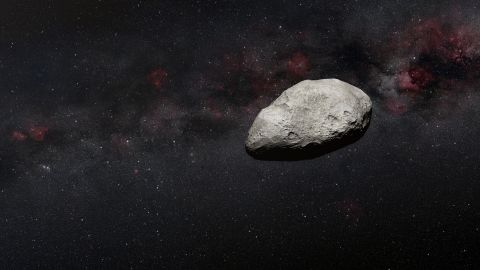Sign up for CNN’s Wonder Theory science newsletter. Explore the universe with news on fascinating discoveries, scientific advancements and more.
CNN —
The James Webb Space Telescope has observed its smallest cosmic object to date — a previously unknown asteroid about the size of the Colosseum in Rome.
A team of European astronomers made the detection of the space rock, which is between 328 and 656 feet (100 to 200 meters) long, and located in the main asteroid belt between Mars and Jupiter.
The doughnut-shaped belt is home to most of the asteroids in the solar system. The main asteroid belt is in close alignment with the ecliptic plane, or the same plane that includes Earth’s orbit around the sun.
The asteroid may be one of the smallest ever found in the main belt. Such small, dark cosmic objects are incredibly hard to observe, but astronomers can use Webb to look for more asteroids of this size in the future.
Further observations will help astronomers learn more about the asteroid in the future and confirm that it is truly a newly discovered object.
The detection of the asteroid was made by chance when the Webb research team focused the telescope’s Mid-InfraRed Instrument, or MIRI, on the main belt asteroid (10920) 1998 BC1, originally discovered in 1998, to take calibration images.
“We — completely unexpectedly — detected a small asteroid in publicly available MIRI calibration observations,” said Thomas Müller, astronomer at the Max Planck Institute for Extraterrestrial Physics in Germany, in a statement. “The measurements are some of the first MIRI measurements targeting the ecliptic plane and our work suggests that many new objects will be detected with this instrument.”

Asteroids are the leftover remnants from the formation of the solar system, and astronomers have determined the location of more than 1.1 million of them.
Many asteroids still remain unknown — and Webb’s find hints that the powerful infrared telescope may uncover plenty more small, rocky objects that have otherwise escaped detection before.
The calibration images the Webb research team took in their attempt to observe asteroid (10920) 1998 BC1 didn’t turn out as expected and were considered a technical failure because the object appeared so bright.
![This image by the NASA/ESA/CSA James Webb Space Telescope's Near-InfraRed Camera (NIRCam) features the central region of the Chameleon I dark molecular cloud, which resides 630 light years away. The cold, wispy cloud material (blue, centre) is illuminated in the infrared by the glow of the young, outflowing protostar Ced 110 IRS 4 (orange, upper left). The light from numerous background stars, seen as orange dots behind the cloud, can be used to detect ices in the cloud, which absorb the starlight passing through them. An international team of astronomers has reported the discovery of diverse ices in the darkest, coldest regions of a molecular cloud measured to date by studying this region. This result allows astronomers to examine the simple icy molecules that will be incorporated into future exoplanets, while opening a new window on the origin of more complex molecules that are the first step in the creation of the building blocks of life. [Image Description: A large, dark cloud is contained within the frame. In its top half it is textured like smoke and has wispy gaps, while at the bottom and at the sides it fades gradually out of view. On the left are several orange stars: three each with six large spikes, and one behind the cloud which colours it pale blue and orange. Many tiny stars are visible, and the background is black.]](https://media.cnn.com/api/v1/images/stellar/prod/230123113224-james-webb-space-telescope-chameleon-i-dark-molecular-cloud.jpg?c=16x9&q=h_144,w_256,c_fill)
Webb telescope peers into the frozen heart of a space cloud
The astronomers were still able to use the data to test a new technique for determining an asteroid’s orbit and size. The observations of (10920) 1998 BC1 were combined with data from the European Space Agency’s Gaia mission and ground-based telescopes.
While analyzing the data, the researchers spotted an “interloper” in their observations — the new asteroid making its first appearance.
“Our results show that even ‘failed’ Webb observations can be scientifically useful, if you have the right mindset and a little bit of luck,” Müller said. “Our detection lies in the main asteroid belt, but Webb’s incredible sensitivity made it possible to see this roughly 100-metre object at a distance of more than 100 million kilometres.”
![Based on new evidence from the NASA/ESA/CSA James Webb Space Telescope, this illustration reflects the conclusion that the exoplanet LHS 475 b is rocky and almost precisely the same size as Earth. The planet whips around its star in just two days, far faster than any planet in the Solar System. Researchers will follow up this summer with additional observations with Webb, which they hope will allow them to definitively conclude if the planet has an atmosphere. LHS 475 b is relatively close, 41 light-years away, in the constellation Octans. [Image Description: Illustration of a planet and its star on a black background. The planet is large, in the foreground at the centre, and the star is smaller, in the background and also at the centre. The planet is rocky. The top quarter of the planet (the side facing the star) is lit, while the rest is in shadow. The star is bright yellowish-white, with no clear features.]](https://media.cnn.com/api/v1/images/stellar/prod/230111134727-01-james-webb-space-telescope-exoplanet-confirmation.jpg?c=16x9&q=h_144,w_256,c_fill)
James Webb Space Telescope discovers its first exoplanet
And astronomers won’t be surprised if other unknown space rocks photobomb future Webb images.
“This is a fantastic result which highlights the capabilities of MIRI to serendipitously detect a previously undetectable size of asteroid in the main belt,” said Bryan Holler, Webb support scientist at the Space Telescope Science Institute in Baltimore, in a statement. “Repeats of these observations are in the process of being scheduled, and we are fully expecting new asteroid interlopers in those images!”


